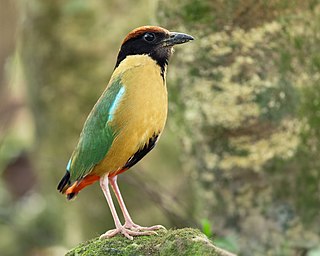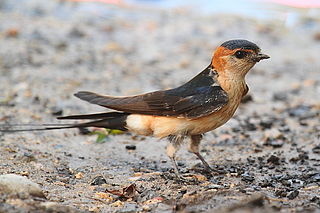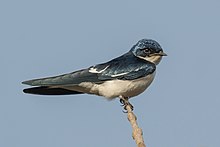
The longclaws are a genus, Macronyx, of small African passerine birds in the family Motacillidae.

The white-winged swallow is a resident breeding swallow in tropical South America from Colombia, Venezuela, Trinidad, and Argentina. It is not found west of the Andes. This swallow is largely non-migratory.

The mangrove swallow is a passerine bird in the swallow family that breeds in coastal regions from Mexico through Central America to Panama. It has blue-green upperparts, blackish flight feathers, a white rump, a black tail, and white underparts. It can be identified by the supraloral white streak, the white line near its eye, which only occurs in two other species of Tachycineta: the violet-green swallow and the white-rumped swallow. The sexes, although similar in plumage, differ slightly in size. The juveniles have grey-brown upperparts and white-washed underparts. This swallow's song is generally described as a soft trilling, with a rolled jeerrt call, and a sharp alarm note.

The dusky crag martin is a small passerine bird in the swallow family. It is about 13 cm (5 in) long with a broad body and wings, and a short square tail that has small white patches near the tips of most of its feathers. This martin has sooty-brown upperparts and slightly paler underparts. The two subspecies are resident breeding birds in South Asia from the Indian subcontinent to southwestern China and the northern parts of Thailand, Vietnam and Laos.

Petroica is a genus of Australasian robins, named for their red and pink markings. They are not closely related to the European robins nor the American robins.

The afep pigeon, also known as the African wood-pigeon or gray wood-pigeon, is a member of the family Columbidae, native to the African tropical rainforest.

The fawn-breasted tanager is a species of tanager with a blue head and yellow breast. It occurs in the Andes of northwestern Argentina, Bolivia, Colombia, Ecuador, Peru and Venezuela, as well as in the highlands of northeastern Argentina, south Brazil, Paraguay and Uruguay.

The Apo myna is a species of starling in the starling family Sturnidae. The species is also known as the Mount Apo starling or the Mount Apo king starling. It is the only member of the genus Goodfellowia. It is endemic to the Philippines found only in the tropical montane forests of Mindanao. It is threatened by habitat loss.

The pitta-like ground roller is a species of bird in the ground roller family Brachypteraciidae. The species is monotypic, having no subspecies. It is endemic to Madagascar.

Lewinia is a genus of birds in the family Rallidae.

The white-banded swallow is a species of bird in the family Hirundinidae. It is black with white thighs, a white breast, and has white bars on the edges of its wings. It has a distinct, deeply forked tail.

The white-backed swallow is a member of the swallow family Hirundinidae and is endemic to Australia. It is the only species placed in the genus Cheramoeca. As with all swallows, it is characterised by adaptation to aerial feeding. It can be identified by its white back, surrounded by black wings and tail. It has a wide distribution, from the southern part of the Australian continent, up to the Tropic of Capricorn. The white-backed swallow prefers grasslands and will create a burrow nest.

The ferruginous antbird is an insectivorous bird in subfamily Thamnophilinae of family Thamnophilidae, the "typical antbirds". It is endemic to Brazil.

The noisy pitta is a species of bird in the family Pittidae. The noisy pitta is found in eastern Australia and southern New Guinea. It eats earthworms, insects and snails. Its natural habitats are temperate forests, subtropical or tropical moist lowland forest, and subtropical or tropical moist montane forest.

The white-rumped swallow is a species of bird in the family Hirundinidae. First described and given its binomial name by French ornithologist Louis Pierre Vieillot in 1817, it was for many years considered a subspecies of the Chilean swallow. The species is monotypic with no known population variations. It has a white supraloral streak, or streak above its lores, which can be used to differentiate it from the Chilean swallow. The lores, ear coverts, tail, and wings are black, with white tips on the inner secondaries, tertials, and greater coverts of the wings. The rest of the upperparts are a glossy blue. Its underparts and underwing-coverts are white, in addition to the rump, as the name suggests. The sexes are similar, and the juvenile is duller and browner with a dusky breast.

The Chilean swallow is a species of bird in the family Hirundinidae. It breeds in Chile and Patagonia, migrating north as far as Bolivia, Paraguay, and Rio Grande do Sul.

The Chatham Islands shag, also known as the Chatham shag, is a species of bird in the cormorant and shag family, Phalacrocoracidae. It is endemic to the Chatham Islands of New Zealand. For a long time the species was placed in the genus Phalacrocorax; today it is mostly placed with the other blue-eyed shags of New Zealand and Antarctica in the genus Leucocarbo. Its closest relative is the Otago shag of South Island.

Galbula is the type and largest genus of the jacamar family (Galbulidae) of piciform birds, and its suborder Galbulae. Sometimes, the Piciformes are split in two, with the Galbulae upranked to full order Galbuliformes.

Cecropis is a genus of large swallows found in Africa and tropical Asia. The red-rumped swallow's range also extends into southern Europe, and into Australia. This genus is frequently subsumed into the larger genus Hirundo.
Reichenow's batis is a passerine bird in the wattle-eye family, Platysteiridae occurring in southeast Tanzania in east Africa. It was formerly treated as a subspecies of the forest batis.






















